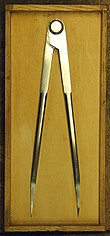Transverse scale
The transversal ruler is used to measure or remove a length measure in cartography or drawing technology.
It is engraved in brass plates or printed on the map edge of topographic maps .
The specialty lies in the fine division by transversal d. H. transverse lines, which enable continuous measurement and thus the highest precision.
The transverse ruler is usually used in conjunction with the dividers . With this a length is tapped (in the map). A compass point is inserted into one of the vertical graduation lines so that the other point is in the field of the transversal (inclined) lines. Then the compass is moved in the vertical graduation so that the second tip engages in one of the transversals. The length is read from this.
The transverse scales were widely used as a drawing aid until the middle of the 20th century. They were engraved in brass plates, but also printed on some paper or cardboard devices (e.g. protractors ). The use of the rulers was also practical because they came in all different units of measure. In spite of the diversity of the length measures used at the same time even in one country, it was possible to switch back and forth between units of measurement without conversion.


